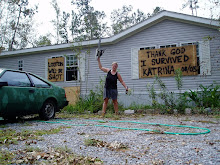
After being served a notice of seizure way too early in the morning, yesturday continued to get even weirder. Suffice it to say that the Universe lit a fire under my ass. Events conspired to point me in one direction; get ready to get outta Dodge, fast. I figure I have about 1 month. My deadline is technically March 25th, but the sooner the better.
So today I am working with fiberglass. I was going to learn to weld, but that requires time to learn, expenses for materials and tools, and I already know how to work with fiberglass since I lived on a boat for two years.
I prefer West Systems epoxy resin. It has several important advantages over polyester resin; It has nifty measuring pumps, so you don't have to measure hardener and possibly get a batch that doesn't cure, it is technically stronger and more moisture resistant than polyester, and it doesn't smell anywhere near as nasty. Naturally it is also more expensive, but I already had some.
With any sort of finish or repair, surface preparation is 90% of success. So I ground the paint down to bare metal, cleaned the entire area with acetone, and filled the deep cracks by the wheel wells with Great Stuff expandy foam. The cracks were then filled with epoxy thickened with colloidal silica and shaped to a smooth surface.
I brushed unthickened epoxy on the areas to be fixed, and started applying fiberglass. It is a good idea to have fiberglass pieces cut to the size of the hole BEFORE you mix the epoxy. It has a limited working time before it starts to cure. After each pice of fiberglass is applied, you add more resin to "wet out" the fiberglass, thoroughly saturating it with resin. There are rollers available to squish out air bubbles and extra resin, but I prefer to massage it, squishing it around with my hand. It's more fun, cheaper, and works just as well. Of course I wear gloves. Epoxy is extremely sticky, and permanently attaches to anything it touches; metal, wood, hair or skin.
I used both fiberglass cloth and glass mat in repairing this hole. Cloth is more flexible than mat, but the more directions the glass fibers are going, the stronger the repair. Mat is good for quick build up of indented areas. I always use cloth for the final layer as it gives a nicer finished surface. It is kind of like paper mache', only permanent and waterproof.
So the holy hippie veggie van has one less hole today. And I'm off to grind more rust.




Woah. That's exactly what I need to do to my friends van to plug up the leaky rust spots. Does it add structural stability (to where the beams in the top of the back door are almost rusted through)?
ReplyDeleteHi Tara, thanks for visiting. It does add structural stability if you do it right. I will probably make 'stringers' (that's what they're called in a boat) that fit into those spaces inside, then glass them in place.
ReplyDeleteBut yeah, it's strong stuff. Even the thin hull (3/8") of my sailboat held up to me ramming docks when my piloting ability was just hatching.